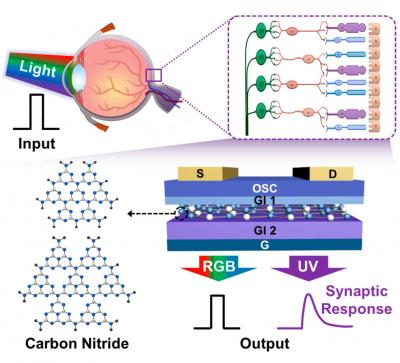Feb 5 2020
Photo-sensitive artificial nerves—made of 2D carbon nitride (C3N4) nanodot materials—with the ability to mimic the functions of a retina have been developed by scientists from Seoul National University and Inha University in South Korea.
 This is a comparison between a biological retina (top) and an artificial photo-sensitive neuromorphic device. Image Credit: Tae-Woo Lee.
This is a comparison between a biological retina (top) and an artificial photo-sensitive neuromorphic device. Image Credit: Tae-Woo Lee.
In addition, the researchers used the photo-sensitive artificial nerves, which selectively detected ultraviolet (UV) light and processed information, to demonstrate a smart window platform for in-situ modulation of exposure to UV rays based on the UV exposure degree and associated risk.
In the field of artificial intelligence (AI) and the internet of things (IoT), neuromorphic electronics that mimic the biological nervous systems are potential candidates to address the difficulties of von-Neurmann computing architecture, for example, high-density integration, data processing rate, and energy efficiency.
Specifically, photo-sensitive neuromorphic electronics are considered to be the main technology for using next-generation smart sensors. The reason is they have the ability to efficiently simulate the functions of biological synapses (the relationship between two neurons, main roles in learning and memorizing) and detect different types of external light information.
But the focus of previous analyses was only on combining synaptic functions and light-sensing in a single device. Therefore, actual applications have not yet been explored.
The study, published in the January 27th issue of Advanced Materials, details retina-inspired photo-sensitive neuromorphic devices that work based on UV-responsive 2D C3N4 nanodot layers to selectively identify and process information related to UV exposure. Although UV light (with a wavelength ranging between 10 and 400 nm) is detrimental to the health of humans, the human retina does not have the ability to detect it.
Therefore, by mimicking the retina, photo-sensitive neuromorphic electronics with the ability to selectively identify and process UV stimuli would improve the visual sense of humans beyond visible light and be useful for healthcare devices. The researchers produced C3N4 nanodots that dominantly absorb UV light and introduced them as a UV-responsive floating-gate layer in transistor geometry.
The exhibited devices consumed energy of just 18.06 fJ per synaptic event, which is analogous to the energy consumption of biological synapses. Moreover, the scientists at Seoul National University combined the devices with UV transmittance modulators and demonstrated in-situ modulation of exposure to UV light.
Further optimization of these smart systems will be carried out to integrate detection and dose-calculation to find out how and when to reduce UV transmittance for preventive health care.
This smart system platform will be widely applicable to advanced electronic skin that is able to automatically adapt to the changing light-dose environment, smart windows that can selectively control transmittance of strong UV lights, smart glasses that detect and block harmful UV rays, smart sensors, artificial retina for soft humanoid robots, and neural prostheses compatible with biological optic nerves.
Tae-Woo Lee, Professor, Seoul National University
Lee continued, “The development of human-like robots, neural prostheses that replicate and expand the human sense, and preventive health care devices can benefit from our work.”
This study was financially supported by the Seoul National University (SNU) and the Ministry of Science and ICT, South Korea.